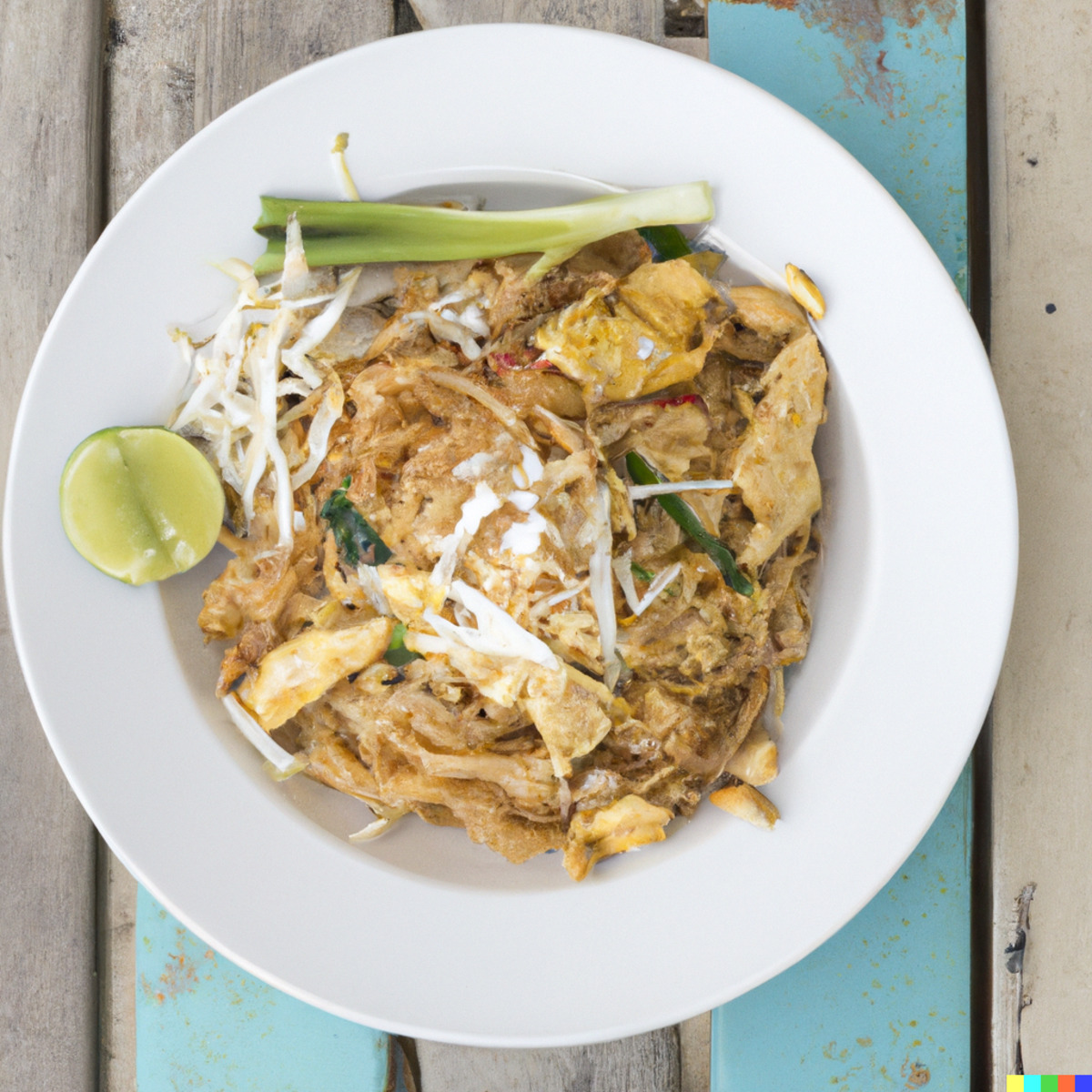
Jump to:
Discovering Lemongrass Chicken Pad Thai opened up a realm of exotic flavors in my culinary world. It's a vibrant dish where simple ingredients morph into a taste celebration under the stir of a wok. The blend of tender rice noodles, fresh veggies, meat, and the iconic trio of tamarind, fish sauce, and a hint of sugar, narrates Thailand's rich culinary narrative with each bite. Pad Thai is a melody of balanced flavors, entwining sweet, tangy, and savory notes, topped with a gentle fiery zest that leaves a longing whisper on your taste buds.
Venturing to create Pad Thai at home was a culinary adventure. Gathering the ingredients felt like reconnecting with old friends through a new lens. The cooking process is a visual and aromatic spectacle that warms the heart. The sizzle of meat, the sautéing garlic and shallots, colorful veggies joining the fray, and the cascade of enchanting Pad Thai sauce that binds the elements in a savory hug, is a pleasing show. The garnish of fresh cilantro and crunchy peanuts isn't just a finish, but an ode to a dish that's a hearty embrace of Thailand's lively culinary spirit.
Why You'll Love This Recipe
A Flavor Voyage: Every bite of this dish is like booking a one-way ticket to the vibrant streets of Thailand. The mingling of lemongrass with classic Thai ingredients envelops your palate in a dance of citrusy, savory, and slightly sweet notes, making each mouthful a journey of exotic flavors.
Simplicity at Its Best: With straightforward steps and a no-fuss ingredient list, this recipe invites both seasoned chefs and kitchen newbies to whip up a Thai classic from the comfort of home. The process is as enjoyable as the end result, making you fall in love with the art of cooking all over again.
Healthful Indulgence: Not only is this recipe an explosion of flavors, but it also packs a nutritious punch with lean protein, fresh veggies, and the natural goodness of herbs. It's a delightful way to nourish your body while satisfying your gourmet cravings.
Picture-Perfect Presentation: The vibrant colors and the beautiful arrangement of this dish make it a feast for the eyes before it even reaches your lips. It’s not just a meal, it’s a photogenic delight ready to grace your dinner table and social media feed with a burst of culinary aesthetics.
What Is Lemongrass?
Ah, lemongrass – the aromatic darling of many a Southeast Asian dish! Stepping into the world of lemongrass is akin to embarking on a flavorful expedition to the tropical regions where this herb calls home. Scientifically coined as Cymbopogon citratus, lemongrass is a tall, perennial grass that boasts a citrusy charm. Its slender, pale green stalks and lush foliage are not just a sight to behold, but a sensory delight, releasing a lemony, earthy aroma when brushed or bruised.
Now, let’s talk about the culinary symphony this herb orchestrates. Lemongrass has the power to elevate dishes with its subtle citrus notes, adding a refreshing zing that’s synonymous with Thai and Vietnamese cuisines. Imagine a steamy bowl of Tom Yum soup or a comforting curry, their flavors are cradled in the heart of lemongrass. But it doesn’t just stop at savory; lemongrass makes a soothing entrance into teas and sweet concoctions too! And here's a little secret: the lower part of the stalk is where the flavor resides, tender and ready to infuse its essence into your culinary creations.
Beyond the kitchen, lemongrass wears many hats. It steps into the medicinal arena with a reputation for soothing digestive woes and calming nerves. As if that’s not enough, lemongrass moonlights in the beauty world too! Its essential oil is a sought-after ingredient in skincare, known for its astringent and antimicrobial properties, making it a natural knight in shining armor against pesky skin woes.
Whether you’re crushing it for a spicy curry, brewing it for a tranquil tea, or dabbing its oil for a refreshing skincare routine, lemongrass is a versatile gem that’s bound to find a loving place in your home. So the next time you come across this humble yet potent herb, give it a nod of appreciation for the culinary and holistic charm it brings along.
Ingredients for Lemongrass Chicken Pad Thai
Noodles and Protein
- Flat rice noodles (7 ounces): These are the backbone of any Pad Thai. Make sure to get the flat variety for that authentic texture.
- Chicken breasts (2, thinly sliced): I prefer chicken for its versatility, but feel free to swap it out—more on that in the substitutions section!
Aromatics
- Lemongrass (1 stalk, finely chopped): This is the star of the show, giving your Pad Thai that unique, citrusy kick.
- Garlic (3 cloves, minced): Because what's a stir-fry without garlic, right?
Vegetables
- Bean sprouts (1 cup): For that much-needed crunch.
- Scallions (½ cup, chopped): These add color and a mild onion flavor.
Garnishes
- Crushed roasted peanuts (¼ cup): For that added crunch and nutty flavor.
- Lime (1, cut into wedges): A squeeze over the top brings everything together.
- Fresh cilantro leaves: Perfect for that herby finish.
Cooking Essentials
- Vegetable oil (2 tablespoons): Any neutral oil will do the job.
- Eggs (2, lightly beaten): For a bit of protein and to make the dish more filling.
Pad Thai Sauce
- Fish sauce (3 tablespoons): The umami powerhouse.
- Tamarind paste (1 tablespoon): For that authentic Thai tang.
- Sugar (1 tablespoon): To balance out the flavors.
- Chili powder (½ teaspoon, adjust to taste): Spice it up or tone it down, your call!
Substitutions - Lemongrass Chicken Pad Thai
Lemongrass: if fresh stalks are elusive, go ahead and use lemongrass paste or dried lemongrass. In a pinch, lemon or lime zest can offer some citrusy notes, but the flavor won't be quite the same.
Fish sauce: Soy sauce or tamari can step in. Keep in mind, though, that you're swapping out a distinctly Thai ingredient, so it'll tweak the flavor profile a bit. If you're avoiding fish due to allergies or dietary choices, there are also vegan fish sauce alternatives out there.
Tamarind paste: A blend of lime juice and brown sugar can make an acceptable stand-in. The ratio is generally 1 tablespoon of lime juice to 1 teaspoon of brown sugar.
Chicken: Shrimp, tofu, or even thinly sliced beef can easily take its place. Just adjust your cooking times accordingly, as these proteins cook differently.
If you're allergic to peanuts, crushed cashews or almonds can add that crunch we all love in a Pad Thai.
Tips and Tricks for the Perfect Pad Thai
Ingredient Prep: Before you fire up that wok, make sure all your ingredients are chopped, sliced, and ready to go. Trust me, the cooking process moves fast, and you don’t want to pause to chop a scallion.
Wok vs. Skillet: If you don’t own a wok, a large skillet can work. However, a wok has the advantage of even heat distribution, making it easier to stir-fry without spilling ingredients.
Egg Technique: When scrambling the eggs in the wok, push them to the edge after they’re set. This allows you to combine them smoothly with the other ingredients without breaking them up too much.
Stir-Fry Sequence: Add ingredients in the order listed in the recipe. This ensures that everything cooks to perfection and you get that harmony of textures.
Noodle Check: Make sure your rice noodles are just al dente before adding them to the wok. They’ll continue to cook as you stir-fry, and you don’t want them turning mushy.
Presentation: Serve your Pad Thai on a platter, garnished and ready for that Instagram moment. Let’s face it; we eat with our eyes first!
Freezing/Storing/Reheating Lemongrass Pad Thai
Freezing: If you're planning on freezing your Pad Thai, I'd recommend doing it without the garnishes like fresh cilantro, lime wedges, and peanuts. Portion the cooked Pad Thai into airtight containers and freeze for up to 2 months. Thaw in the refrigerator before reheating.
Storing: Leftovers can be stored in the fridge for up to 3-4 days. Again, keep the garnishes separate to maintain the texture and flavor of the dish.
Reheating: The microwave is a quick and easy option, but it can make the noodles a bit mushy. My personal recommendation? Toss the leftovers in a hot skillet with a splash of water or a bit of extra Pad Thai sauce to bring it back to life. Stir constantly to ensure it heats evenly and doesn't stick to the pan. Once it's hot, garnish with your saved or freshly chopped cilantro, crushed peanuts, and a wedge of lime.
Recipe
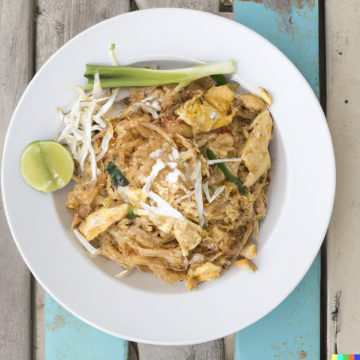
Lemongrass Chicken Pad Thai
Equipment
- Medium pot
- Bowl
- Pestle and mortar (optional)
Ingredients
- 7 ounces of flat rice noodles
- 2 chicken breasts thinly sliced
- 1 stalk of lemongrass finely chopped
- 3 cloves garlic minced
- 2 eggs lightly beaten
- 1 cup bean sprouts
- ½ cup chopped scallions
- ¼ cup crushed roasted peanuts
- 2 tablespoons vegetable oil
- 1 lime cut into wedges
- Fresh cilantro leaves for garnish
Pad Thai Sauce:
- 3 tablespoons fish sauce
- 1 tablespoon tamarind paste
- 1 tablespoon sugar
- ½ teaspoon chili powder adjust to taste
Instructions
- Start by soaking the flat rice noodles in warm water for about 10-15 minutes, until they soften. Once soft, drain the water using a strainer and set the noodles aside.
- Prepare the Pad Thai sauce by mixing the fish sauce, tamarind paste, sugar, and chili powder in a bowl. Stir until the sugar has completely dissolved.
- Heat the vegetable oil in a wok or large skillet over medium heat. Add the chopped lemongrass and minced garlic. Sauté for 2-3 minutes until they start to release their aroma.
- Add the thinly sliced chicken breasts to the wok. Stir fry until the chicken is fully cooked, around 5-7 minutes. Remove the chicken and set it aside, leaving the lemongrass and garlic in the wok.
- Push the lemongrass and garlic to one side of the wok, then pour the beaten eggs into the other side. Let it set for about 30 seconds, then scramble the eggs and mix them with the garlic and lemongrass.
- Add the soaked and drained noodles to the wok. Pour the Pad Thai sauce over the noodles. Stir fry for 2-3 minutes until the noodles are soft and have absorbed the sauce.
- Return the cooked chicken to the wok, adding the bean sprouts and half the chopped scallions. Stir fry for another 2 minutes, until everything is well combined and heated through.
- Serve the Lemongrass Chicken Pad Thai garnished with the remaining scallions, crushed peanuts, fresh cilantro leaves, and a wedge of lime on the side. Encourage everyone to squeeze the lime over their serving for a refreshing citrus kick!
Nutrition
Lemongrass Chicken Pad Thai - FAQ
Absolutely! Chicken thighs are actually juicier and more flavorful. Just make sure to adjust the cooking time as thighs may take a bit longer to cook through.
No problem! Tofu is an excellent substitute for chicken. Make sure to press it well to remove excess moisture before stir-frying. You can also use tempeh or even seitan if you prefer.
You can, but it won't taste quite the same. For a vegetarian alternative, try using a soy sauce and a little bit of seaweed flakes for that oceanic umami flavor.
Yes, you can mix lime juice with a touch of brown sugar as a makeshift substitute. The ratio is generally 1 tablespoon of lime juice to 1 teaspoon of brown sugar.
You can certainly prep the ingredients ahead of time, but Pad Thai is best when stir-fried just before eating. However, the Pad Thai sauce can be made in advance and stored in the fridge for up to a week.
While this dish is quite filling on its own, it pairs well with simple Thai salads or soups like Tom Kha Gai.




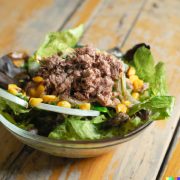



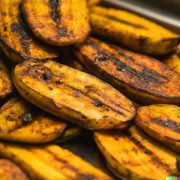
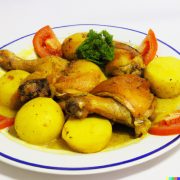
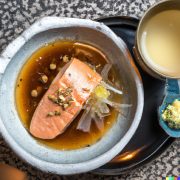



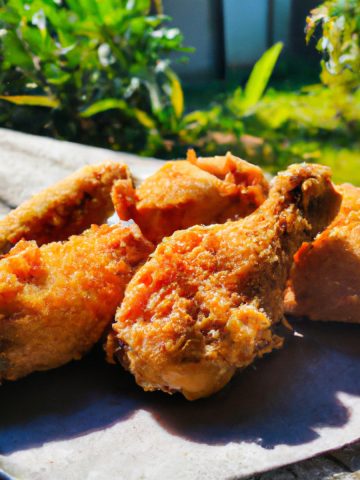
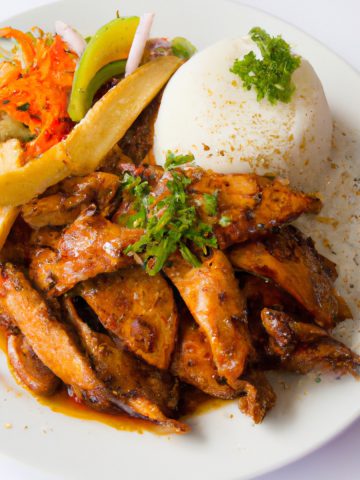
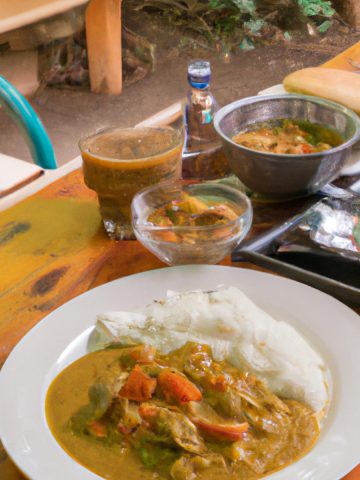
Amy Frosten says
The lemongrass is a nice touch
Steven Granderson says
pad thai is one of my all time favorite stir fry dishes